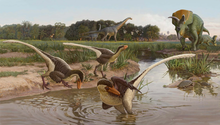Dineobellator
| Dineobellator | |
|---|---|

| |
| Skeleton reconstruction, featuring the known elements in white | |
| Scientific classification | |
| Domain: | Eukaryota |
| Kingdom: | Animalia |
| Phylum: | Chordata |
| Clade: | Dinosauria |
| Clade: | Saurischia |
| Clade: | Theropoda |
| Family: | †Dromaeosauridae |
| Clade: | †Eudromaeosauria |
| Genus: | †Dineobellator Jasinski et al. 2020 |
| Type species | |
| †Dineobellator notohesperus Jasinski et al. 2020
| |
Dineobellator (meaning
Discovery and naming

The holotype remains are designated SMP VP-2430 and were first recovered in 2008 from the Ojo Alamo Formation by Robert M. Sullivan, Steven E. Jasinski and James Nikas. Sullivan and Jasinski collected additional material in 2009. In 2011, the find was reported in the scientific literature.[3] Further excavations were performed by Jasinski in 2015 and 2016.[2]
The remains were realized as belonging to a new taxon, which was only named and described in 2020, by Jasinski, Sullivan and
Description

Dineobellator was a dromaeosaur similar in size to Velociraptor and Saurornitholestes. Unique features of the skeleton suggest greater hand and feet flexion than normal for dromaeosaurs, a tighter grip strength in the manual unguals, and greater movement at the tail base. These may aid in agility and predation. Additionally, the presence of quill knobs on the ulna suggest it was feathered, as assumed for all dromaeosaurids.[2]
Classification
| Eudromaeosauria |
| |||||||||||||||||||||||||||||||||||||||||||||||||||||||||||||||
However, two years later, Jasinski et al. 2022 re-examined the holotype, and found Dineobellator to be a member of Eudromaeosauria, but not within Velociraptorinae, Saurornitholestinae and Dromaeosaurinae.[4]
| Dromaeosauridae |
| ||||||||||||||||||||||||||||||||||||||||||||||||
Paleobiology
One of the claws on the right hand of the type specimen of Dineobellator bears a gouge, the size of which is consistent with the claws of a similarly-sized theropod, possibly another Dineobellator. No evidence of healing is present, suggesting that the injury occurred close to the time of death. A broken and re-healed rib was also documented in the specimen.[2]
Palaeoenvironment

Dineobellator is part of the
References
- ^ Gramling, Carolyn (26 March 2020). "Fossils of a new dromaeosaur date to the end of the Age of Dinosaurs". Science News.
- ^ PMID 32218481..
 Material was copied from this source, which is available under a Creative Commons Attribution 4.0 International License
Material was copied from this source, which is available under a Creative Commons Attribution 4.0 International License - ^ S2CID 210927955.
- S2CID 253382718.
External links
- Ferreira, Becky (26 March 2020). "Fossils Show Raptors Prowled North America Late in Dinosaurs' Era". The New York Times.
